bat 5

WYŚWIETL E-BO OKA
Zdobądź tę książkę w postaci wydrukowanej ▼
■ g+i o
★ ★★★★
0 Recenzje Napisz recenzję
Ethnicity and Violence: The Case of Radical Basque Nationalism
Autorzy Diego Muro
Herri Batasuna ETA Wyszukaj
Informacje o książce
► Moja biblioteka ► Moja historia Książki w Google Play
Wynik 17 z 30 w tej książce dla zapytania Herri Batasuna ETA - < Poprzednia Następna > - Wyświetl wszystko W/czyść wyszukiwanie [x|
or tne Etfropean commumty memncrstateś; ano tne eśtaDiT^IimcTTr or Information cxchange mcchanisms betwcen the different institutions and par-ties involved. The pact was a political success for the socialist government led by Felipe Gonzalez, which had managed to put together parliamentary support for the first ever pact against terrorism. It was also the beginning of an era in which the ruling party and the opposition would usually agree on security policy as a kcy issue (tema de estado) and the parliament would be uscd as backup for governmcntal policics against terrorism.
Second, two months later, the Pact for the Normalisation and Paci-fication of Euskadi, was signed by all Basque political forces with seats in the regional parliament except Herri Batasuna. This second anti-ETA agreement was the result of fifty intense hours of negotiation and came to be known as the Pact of Ajuria Enea, sińce it had been signed in the residence of the Basque prcsident, the Pałace of Ajuria Enea on 12 January 1988.4 The accord was a longer document than the Pact of Madrid and its first goal was to denounce ETA’s interference with Basque politics and emphasise the role of the autonomous Basque government in finding a solu-tion to the problem of violence. The agreement was madę up of seventeen points, and most of the Basque political forces agreed on the importance of reinforcing the legitimacy of politics in finding Solutions to political
Strony wyświetlane za zezwoleniem Routledge. Prawa autorskie.

S https://books.google.pl/books?id=Jsns8ro5pR0C&pg = PA129&dq = Herri + Batasuna + ETA&hl = pl&sa=X&ei=9sk5VbrxD5PjarGDgdgH&ved = 0CC8Q6AEwAQ#v=c
Herri Batasuna ETA
+Wsh
Batasur ym Ethnicrt g Terroris

|
Książki |
I * | Cl 1 |
i na 55 |
co |
Dodaj do mojej biblioteki |
Napisz recenzję |
Strona 146 ▼ |
< > |
0 - |
Wynik 17 z 30 w tej książce dla zapytania Herri Batasuna ETA - < Poprzednia Następna > - Wyświetl wszystko
Wyczyść wyszukiwanie [xj
WYŚWIETL E-BO OKA
Zdobądź tę książkę w postaci wydrukowanej ▼

g+i ,o| ★★★★★
0 Recenzje Napisz recenzję
Ethnicity and Violence: The Case of Radical Basque Nationalism
Autorzy Diego Muro
Herri Batasuna ETA Wyszukaj
Informacje o książce
► Moja biblioteka
► Moja historia Książki w Google Play
dccKkTtlicir own futurę*. T he other points madę reierence to issues such as the role of the Basque executive and the Lebetidakari in the ‘eradication of terrorism’, the importance of intcrnational collaboration, the role of the ‘rule of law’ in helping the victims of terrorism, and favouring the insur-gents’ reinsertion in society. Although the agreement saw a combination of the rule of law and police actions as a means to eliminate ETA’s nationalist yiolence, it also opened the door to negotiations with the armed group if certain conditions were met. The text called for the support of other social and political institutions for the agreement in order to fight ETA. The text madę references to Basque civil society and its political institutions but also to the Council of Europę and the Spanish, Navarrese, and European parliaments. By bringing on board all these actors, the pact aimed to isolate ETA and its anti-system political wing, Herri Batasuna, and redefine the ‘Basque conflict’. The pact concluded that the Basque problem was not a historical conflict between the Basqucs and Spaniards but was due rather to the existence of a violent group which did not respect sonie of the most fundamental rights and freedoms (such as the right to life, liberty, and security of person). The promoter of the agreement, the Lehendakari Jose Antonio Ardanza, commented that up until 1988 the conflict had been seen in ‘nationalist terms’; from that moment onwards it had to be seen in ‘democratic terms’ (Rivera 1998: 91). The Pact of Ajuria Enea established a elear cleavagc that dividcd an ovcrwhclming majority which was in favour of party politics and democracy from an intransigent minority that was ready to use all available means, including violence, in order to achieve its political objectives.
Third, an Agreement for Peace and Tolerance was signed in Pamplona (Navarre) in October 1988.5 This last text was much shorter than that
Strony wyświetlane za zezwoleniem Routledge. Prawa autorskie.

Wyszukiwarka
Podobne podstrony:
bat 6 WYŚWIETL E-BO OKA Zdobądź tę książkę w postaci wydrukowanej ▼ 8+1 ,o
bat 7 WYŚWIETL E-BO OKA Zdobądź tę książkę w postaci wydrukowanej ▼ 8+1 ,o
bat 6 WYŚWIETL E-BO OKA Zdobądź tę książkę w postaci wydrukowanej ▼ 8+1 ,o
bat 7 WYŚWIETL E-BO OKA Zdobądź tę książkę w postaci wydrukowanej ▼ 8+1 ,o
bat 3 -—- WYŚWIETL E-BO OKA Zdobądź tę książkę w postaci wydrukowanej ▼ ■ g+i o★ ★★★★ 0
bat 3 -—- WYŚWIETL E-BO OKA Zdobądź tę książkę w postaci wydrukowanej ▼ ■ g+i o★ ★★★★ 0
bat 1 5.2.2 Heni Batasuna Zdobądź tę książkę w postaci wydrukowanej ▼ 8+1 ,o
ETA nad?sque 1 KUP E-BOOKA-438,90 ZŁ Zdobądź tę książkę w postaci wydrukowanej ▼ 8+1 ,o
ETA nad?sque 2 KUP E-BOOKA-438,90 ZŁ KUP E-BOOKA-438,90 ZŁ Zdobądź tę książkę w postaci wydrukowanej
ETA nad?sque 3 KUP E-BOOKA-438,90 ZŁ KUP E-BOOKA-438,90 ZŁ Zdobądź tę książkę w postaci wydrukowanej
bat 9 WYŚWIETL E-BO OKA Wynik 25 z 30 w tej książce dla zapytania Herri Batasuna ETA - < Poprzedn
Image221 Funkcje te mają postać:DA = ADb = AB+AB = A@BDc = AC+BC+ABĆ = C(A+B) + CAB = CAB+CAB = AB@C
więcej podobnych podstron